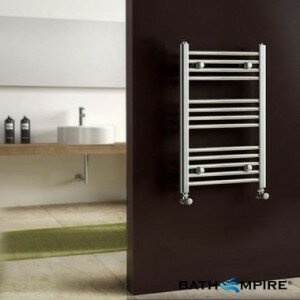Saving Money on Your Central Heating Bill
Posted on 30. May, 2012 by Nitin in Advice

Natasha Chrome Towel Radiator, 700mm, from BathEmpire
We all know that during the summer months, we can rest assured that our gas bills won’t be breaking the bank. But once the present heatwave has passed, in a few months you’ll be battling the cold dark winter nights. Thankfully, there are some simple things you can do to make your life cheaper.
In this post, we will share some tips to help you save some money on your heating bills.
Top Tip:
Did you know that by turning down your thermostat by just 1 degree, you can save up to £55 a year.
How do Central Heating Systems Operate?
Central heating systems are powered by gas, oil or electricity, and variations of these systems are found in most of our homes. The pump then pushes the heated water around the system and through each radiator in turn. The water cools around its journey, and it returns to the boiler to be reheated. This process creates waste gases such as steam and carbon monoxide, which escape through a flue to the outside. Condensing boilers use these gases to reheat the water, cutting down on the energy used; a modern aerated boiler converts over 91% of its fuel energy into heat, compared with an average of only 70% from a normal boiler. If your boiler is over ten years old, it really is cost effective to replace it. Converting from a G-rated to a modern boiler could amount to a £225 saving in a year! But if you’re not in a position to replace your boiler, then let’s have a look at how you use your room thermostats.
Thermostatic Control
Instead of a simple switch control, most radiators have room thermostats which allow you to control the temperature in each room. This is increasingly handy, as
as you wouldn’t heat an empty room to the same level as the bathroom or kitchen. But the real big hitters when it comes to efficient heating are thermostats and programmers. These allow you to maintain a certain temperature; if the temperature is too low, then the heating will kick in and when its too high enough, the boiler will switch off.
In most homes, it takes around 20 minutes for the boiler to heat the rooms, although slightly longer if conditions are icy. The best thing to do is to set your programmer to come on at least 20 minutes before you get up in the morning, and then again 20 minutes before you get home from work. This allows you to enjoy a warm home only when you need it, and is far more efficient than turning the temperature up to full blast.
A comfortable temperature is likely to be around 18-20 degrees, but try turning it down by a further degree, and see the savings you could make.
Energy Efficient
Another tip is to add a liquid inhibitor to your heating system every year, to protect against corrosion and limescale. This helps your boiler to run at optimum efficiency.
The heat from your radiators can be lost through the wall; one way to get round this is to install a reflective foil. The great thing is that you don’t have to remove the radiator in order to install this .
Electric Radiators
If you are only looking at heating one room, such as an en-suite bathroom, then it may be worth considering a thermostatic electric radiator. As these do not connect to your central heating system, you will only use the electric energy you need.
Have you got any other tips on how you save energy?
